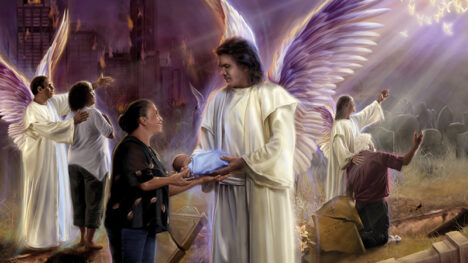
“On our farm in South Dakota, there was a covered cattle watering tank. My brothers would often challenge each other to enter an opening at one end of the tank and then emerge from an opening at the other end. One afternoon, when I was five, I was shamed into trying it. Inside the tank I lost my way. The next three minutes seemed like hours. I struggled frantically for the opening, banging my head and hands against the sides and the top of the covered, water-filled tank. My head and lungs seemed to be exploding and I became frantic as I realised that I might be drowning. Then, just as suddenly, a tremendous sense of pleasant calm swept through me. I remember clearly thinking, I am drowning, but I was not afraid.”
Lawrence Den Besten, a professor of surgery, recalled this experience during a speech at Pasadena, California. He went on to describe what he experienced during the short time that he was near death. He saw himself lying in his coffin and all those who passed by the casket. Then, “suddenly, I became aware that I was being held by my feet. My head was pounding terribly, and I was coughing. For 47 years I have reflected on these memories. Now I realise . . . that I was going through a typical experience of dying.”
In 2015, the movie 90 Minutes in Heaven was released. It was presented as the true story of Don Piper, the victim of a horrific car crash who was pronounced dead on the scene, but revived later in hospital. He then told those around him that he’d had a near-death experience in which he’d seen God in an overwhelming bright light in the middle of the heavenly Jerusalem. Piper saw and heard the voices of many fellow-Christians who also were on their way to their heavenly home. After recovering from his injuries, he began to talk about his experiences and assured others that heaven is real.
These are just two of thousands of similar tales. Between 1975 and 2005, more than 3500 cases of such experiences were reviewed by researchers. According to nine contemporary studies from four different countries, between 10 and 20 per cent of people who have come close to death have had near-death experiences. Small wonder that a distinct discipline of near-death experience (NDE) studies has developed. We are not dealing with an insignificant fringe phenomenon, but with something of major global importance.

Describing NDEs
What do we make of these experiences? Do millions of men and women wordldwide, at the brink of death, have the opportunity to temporarily take leave of their body and get a glance of the world “on the other side”? And are these experiences an irrefutable argument for the existence of life after death?
First, we do well to describe NDEs in a little more detail. We will follow the list of common traits as developed by Raymond Moody, the pioneer researcher who, in 1975, coined the term near-death experience:
1. There is a strange sound: a buzzing or ringing noise, while the person has a distinct sense of being dead.
2. The dying process may be painful, but as soon as one leaves the body the pain is gone and peace prevails.
3. The person has the sensation of rising up and floating above their body while the medical team stands around them. They often hear how they are pronounced dead. They have the sensation of being some sort of spiritual body that is weightless, invisible and inaudible, and there seems to be a kind of living energy field.
4. The next experience is that of being pulled into a dark tunnel, at great speed, towards a realm of brilliant light. This tunnel experience may be rather scary for some, but it does not give the sense of “going to hell”, and for most it is actually quite pleasant.
5. Most people then report that they see the earth as if they are in space.
6. Having arrived on the other side of the tunnel, they meet people who are glowing with an inner light. Often friends and family members who died earlier are at hand to greet them.
7. There is usually a Being of Light, whom they later identify as God or Jesus or some religious figure. In most cases the recipients of this experience are at a total loss for words to describe what they have seen.
8. This Being of Light presents them with a panoramic view of their life. Good deeds, as well as selfish deeds, are flashed back. The review is non-judgemental. The emphasis is on taking advantage of opportunities to love others and acquiring knowledge.
9. There usually is a limit or border that they cannot cross. To do so would be to join those who are on the other side and are permanently in heaven. After this experience they tend to be very reluctant to return to “normal” life.
Cultural factors
We must take into account that, although reported NDEs show quite similar patterns, they are not identical and do not always follow the exact same sequence. Also, it would seem that the experiences are subject to cultural conditions. Near-death experiences do not only occur in the Christian West, but also among adherents of other religions. What Hindus and Buddhists see, for instance, when they are near death corresponds largely with the ideas about the afterlife in their faith traditions.
Over time, there have also been major changes in the way people of different times experienced the nearness of death and their encounters with those who have already reached their eternal destination. The experience “God” offers nowadays seems to be more congenial to Western minds.
What the Bible says
The single most important problem with NDEs is that the Bible forces us to reject the thesis that these experiences are in fact what so many people believe they are. Near-death experiences are not quick excursions to heaven. Whatever people see and experience, it is not the soul’s absence from the body, or the presence of God or Jesus, and it does not offer a true encounter with loved ones who have preceded them in death.
Bible-believing Christians accept that dreams can have a divine origin (though most dreams do not), and that God can give visions and reveal things to men and women whom He chooses—the earliest examples are recorded in the Bible. These things should not blind us, however, to the incontrovertible fact that the dead “sleep” in their graves, unconscious of anything that happens on earth, and they wait for the day of the resurrection. (See 1 Thessalonians 4:13–18.)
When we take the Bible seriously there is only one conclusion: near-death experiences are not what they are often made out to be. But what alternative explanation could there possibly be?
The near-death brain
Oxford scholar Michael Marsh, who shortly before his retirement wrote a doctoral dissertation about neurophysiological and theological approaches to near-death and other out-of-body experiences, urges us to pay close attention to the term near death and asks the very pertinent question: “Can a subject near death simultaneously inhabit another realm, supposedly beyond death?”
Several experts have pointed out that a brain that is “starved of oxygen, drugged by hallucinatory painkillers or excited by fever, is hardly likely to function properly, and who knows what visions could be accounted for by its disturbed conditions?”
Jack Provonsha, a theologian and medical doctor, studied the near-death phenomenon in depth. He told the story of a patient in Loma Linda, California, who claimed that over a 10-year period he had “left his body” at least 15 times. The man was eventually diagnosed as having a slow-growing pituitary tumor. After this tumor was surgically removed, his “out-of-body” experiences ceased.
Provonsha points out that a study of psychedelic literature is extremely relevant in this connection. He maintains that almost every aspect of the descriptions given by those who have had a near-death experience “is matched line for line by the users of hallucinogens such as LSD”.
And Professor Den Besten, whose near-death experience was related at the beginning of this article, stated, “All the material I have presented comes from patients who have survived the dying experience and are alive to talk about it. . . . these data have nothing to do with what happens after death.”
The journey begins
I am prepared to take a leap of faith; to believe that, like life, death has to do with a dimension that exceeds our human comprehension. Life originates with the divine Source of Life, and death is caused by a separation (at least temporarily) from this Source of Life. As humans on this side of eternity, we must realise that our knowing will for now remain partial (1 Corinthians 13:12). Nonetheless, I fervently hope that you will continue to explore this topic and that what you find will strengthen your commitment to the God of life, and reinforce your faith in the new miraculous kind of life that He wants to give us after our present existence has ended.
Reinder Bruinsma worked for the Seventh-day Adventist Church for more than 40 years in Europe, West Africa, the UK, and the USA. Now retired in his home country of the Netherlands, he continues to be active as a speaker and writer. This article is adapted, with permission, from his latest book, I Have a Future: Christ’s Resurrection and Mine (2019, Autumn House).









